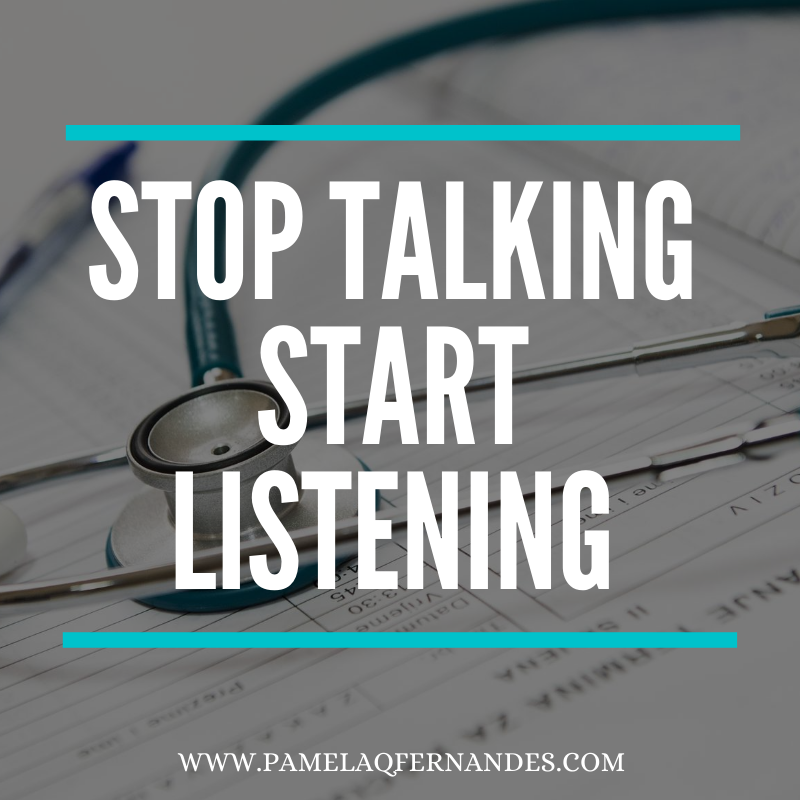
This week we were asked to attend a training session on communications to improve doctor patient conversations. And so as I was taking notes, I decided to create a post about it. A lot of these tips are for both; the outpatient and inpatient but they’re more necessary in the inpatient setting since basic principles of conversation and communication are basically ignored.
10 Steps to Better Doctor Patient Conversations
Here are ten steps to better doctor-patient conversations.
1. Start with Empathy
Come to the table with empathy. Everybody is battling something. They all have their crosses to bear and obstacles to overcome. Think of where people are coming from. They have a lot on their plate as do you.
Never:
assume that their matters are trivial while yours are all important. Its easy to pull rank and feel rank in a hospital setting, especially if you’re at the top of the food chain. Don’t give in to the temptation to look down but look sideways. There’s this beautiful video from Cleveland clinic that I have shared widely. You must have already seen it but here it is.
2. Pay Attention
The second step is in my 10 steps to better doctor patient conversations is pay attention. You must have always heard advice to nod and repeat the last word of a sentence when a person is talking so it looks like you’re paying attention.
People!
You don’t have to fake paying attention if you’re actually paying attention.
Celeste Headlee
Follow the conversation, even if you’re falling off the cliff.
3. Be In The Moment
While you’re talking with a patient or their family member, don’t think about the CT scan for the previous patient, or how your Chief wants you make the numbers or whether they did the booking for this weekend’s date night.
Stay present in the moment.
Stop multitasking, fiddling with your phone, reading the EMR, and all of that. Be fully present with all your faculties.
4. Don’t listen to respond
Stephen Covey, author of The Seven Habits of Highly Effective People said that,’Most people do not listen with the intent to understand; they listen with the intent to reply.‘
Hold your horses. Don’t wait to interject with your response. Often patients are asking askew, read between the lines. Sometimes they’re not even asking. They’re just telling. You don’t have to wait for them to breathe so that you give them your two bits.
5. Don’t Repeat Yourself
If the patient doesn’t understand something the common strategy I’ve seen among doctors is to repeat what they’re saying but with a more forceful tone and a higher decibel. Have you seen this happen in doctor patient conversations?
I have and its embarrassing.
We’re pressuring and scaring the patient to understand and make them cower into understanding. Who are we fooling? Instead, try another way, reset, and ask questions, break it down, and start all over if your have to. And for goodness sake, don’t pontificate. Nobody likes it.
6. Ask open ended questions
Journalists are supposed to ask who what, where, when, why? Ask these instead of leading questions. Let them describe what they’re feeling for you. Yes and no answers might be great to help you rule out your differential but let the patient diagnose their condition for you by giving you a full picture.
7. Assume everyone knows something
People are not idiots. Everyone is a subject matter expert on something. In every encounter with a patient, look for something to learn. That gives you a healthy measure of respect for the person sitting in front of you or lying in bed even though they’re sick. Assume everyone knows something.
8. Don’t Equate Experiences
Do not say to patients, “you understand.” Even if you have had the very same breast cancer yourself, or if you’ve had a family member who went through the exact same experience, do not say that you understand. Because you don’t. Everybody is different and their experiences are different. Don’t boast and say how you handled something better. This is their time. Let them have it.
9. Be Selfless
This is not about you. I’ve seen many doctor patient conversations. And it’s strange, how sometimes physicians can make an entire conversation about themselves while a patient is telling their story, even in the IPD when the patient is sick and in bed.
Put your your ego to sleep and step aside. Get out of your own head. Stop being superficial and get to know this person. This is not your drama. Be selfless and focus on the patient and their story. Give them the attention they deserve.
10. Listen, really listen
I know, listening takes time and energy. You’d rather get to the next patient on the list, see that consult you got beeped about, review the labs, answer all these messages, write those prescriptions, answer those emails, deal with that mountain of paper work if only this patient would stop talking. They will at some point and they will sooner, if you’re really listening.
Listen.
Actively listen. It takes work but listen. This will only be possible if you’re really interested in other people.
Your Turn
Do you have some recommendations for better doctor patient conversations. Let me know. Also, check out some of our other posts on staying creative in medicine.